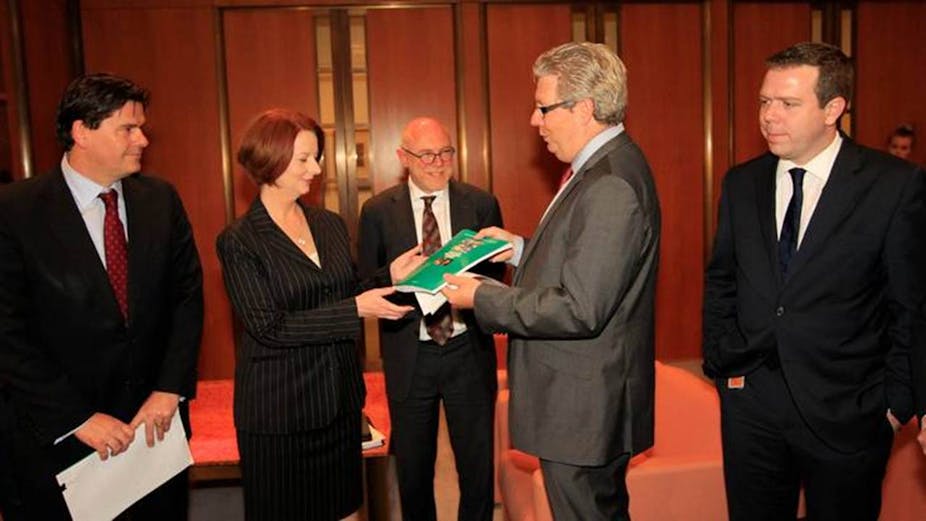Can anything new be said about the future of manufacturing in Australia?
Yesterday’s report, Smarter Manufacturing for a Smarter Australia submitted yesterday to Prime Minister Julia Gillard, is a detailed and comprehensive attempt to do so, and to propose practical ways forward for government in collaboration with industry, trade unions and public research organisations.
While there has been considerable discussion of the problems facing manufacturing in an increasingly high cost environment, driven by Australia’s terms of trade and high dollar, too little attention has been given to the opportunities to reposition our manufacturing for competitive advantage in global markets and supply chains.
This is the purpose of the report by the non-government members of the Prime Minister’s Manufacturing Taskforce. The Taskforce was established last year as job losses began to accelerate in manufacturing and the threat of closure loomed over major production facilities, especially in the automotive industry. It comprises 12 key industry and trade union leaders and three independent experts, and is supported by a secretariat from the Department of Industry, Innovation, Science, Research and Tertiary Education.
The Taskforce took seriously its terms of reference to “establish a shared vision for the future of the manufacturing sector”, and drew on examples of competitive high skill, high productivity manufacturing in northern Europe and the United States to demonstrate its continuing viability in advanced economies, which have withstood and in some cases reversed the trend to offshoring production activities.
The report makes the case for a strong manufacturing sector in Australia in the context of a huge but precarious commodity boom, whose terms of trade effects may soon have run their course, only to refocus policy on the need for a balanced and diversified economy with a renewed emphasis on productivity improvement. Manufacturing is an essential component of such an economy as it drives technological change and innovation and contributes to our external trade position.
However, the report also recognises that while technology innovation is closely linked to manufacturing success, particularly in high tech industries, non-technological innovation is just as important if not more so for low and medium tech industries, which make up the bulk of manufacturing in advanced economies, including Australia.
Non-technological innovation can take a variety of forms. For example, business model innovation deploys existing technologies in new combinations for new markets. Design innovation enables strategic reinvention and creates new customer experiences. And organisational innovation promotes high performance work and management practices. These forms of innovation are not as well understood in Australia as they should be.
Consequently, while some of the proposals in the report are familiar, others are relatively new to the public policy debate. The Taskforce proposes far-reaching new policy directions in the following five areas.
First, to address the short-term challenges facing Australian manufacturers, and the very real danger of large losses of jobs and capabilities, measures are proposed to boost the public and private investment pipeline, strengthen value capture from large projects in the current pipeline and help businesses, workers and communities manage change.
Second, to reinvigorate economy-wide productivity growth, encourage investment and reduce the costs of doing business, the Taskforce proposes a targeted stimulus to demand and initiatives in transport, broadband, energy, regulation and taxation.
Third, to address Australia’s underlying competitiveness, deeper collaboration is proposed not only to generate, but also to disseminate and apply knowledge. As part of a medium to longer term strategy, the Taskforce advocates the development of globally-oriented innovation hubs and precincts that build critical mass around our comparative advantages, as well as a new “Smarter Australia Network” linking businesses and research organisations.
Fourth, to address the multiple barriers facing small and medium enterprises (SMEs), and to help more SMEs grow into the innovative, global mid-sized firms Australia lacks, the Taskforce proposes that Enterprise Connect be expanded and that new measures are put in place to address the weak contributions researchers and governments make to SME innovation, to lift the capacity of SMEs to absorb new knowledge, to introduce and embed a greater focus on design and to improve access to finance.
Fifth, to sustain productivity growth into the future with continuous innovation in managerial and workforce skills and practices, a new national conversation and partnership between industry, unions and government around “Smarter Workplaces” is proposed. This will involve a sustained commitment from the partners to build the innovation culture and capabilities that high performance workplaces demand.
The Taskforce believes that manufacturing has a future in Australia, but only if it is able to innovate and reposition up the global value chain. It is now the turn of government to respond in an industry statement later in the year to the proposed policy measures, which provide a coherent framework for implementing this shared vision.

